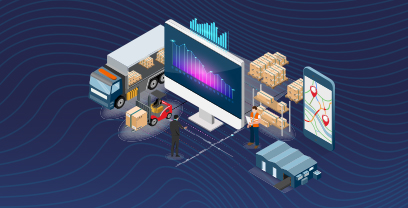In today’s rapidly changing business landscape, where demand can shift in an instant and disruptions are the new normal, organizations must anticipate what’s coming next and even peer around corners to gain a competitive edge.Supply chain disruptions pose significant financial challenges, with global organizations losing an average of $184 million annually, according to a 2021 survey. Businesses that optimize their supply chains reduce supply chain costs by 15% and experience 3X faster cash to cash cycles. Furthermore, accurate demand forecasting is critical to achieving such optimization.
Effective supply chain management (SCM) forecasting transforms chaos into clarity, helping companies anticipate needs, optimize inventory, and ensure smooth operations.
But supply chain forecasting isn’t just about predicting the future – it requires the insight to turn unknowns into opportunities. Thus, maintaining supply chain resilience to navigate today’s market volatility is crucial.
In this post, we explore the “ins and outs” of supply chain forecasting, including common challenges and best practices. You’ll learn about various demand forecasting methods within supply chains, and how procurement technology can help you forecast with confidence.
What Is Supply Chain Forecasting?
Supply chain forecasting is the art and science of predicting the future needs of your business to keep everything running like a well-oiled machine. Imagine having the crystal ball to foresee demand spikes, maintain optimal inventory levels, and fine-tune your resource allocation. By mastering this forward-thinking process, businesses can streamline operations, slash costs, and curb waste, all while reducing inefficiencies.
With smart supply chain forecasting, you’re not just reacting to changes—you’re anticipating them, ensuring your business is always ready to adapt and thrive.
A demand forecasting model can analyze data from suppliers and customers to predict future prices of products. By assessing trends in supplier costs, customer orders, and market conditions, teams gain insights into potential price fluctuations and thus can make strategic purchasing decisions or proactively negotiate better terms with suppliers.
Effective supply chain management and SCM forecasting are vital for demand planning, inventory management, and resource allocation. The primary goals include:
- Demand Planning: Accurately predicting customer demand to avoid stockouts or overstocking.
- Inventory Management: Balancing inventory levels to reduce holding costs while maintaining sufficient stock to meet demand.
- Resource Allocation: Optimizing labor, materials, and production capacity to improve efficiency and reduce costs.
Supply Chain Forecasting Methods for Effective Demand Planning
There are three primary forecasting models you can use for effective supply chain management: qualitative, quantitative and hybrid. Let’s explore each of these in detail.
Qualitative Forecasting
Qualitative forecasting relies on expert judgment, intuition, and subjective insights rather than insights based on historical data. It’s often used when there is limited data available, such as during new product launches, market shifts, or when entering uncharted territories. Qualitative forecasting relies on the expertise and opinions of knowledgeable individuals to provide insights that numerical data alone cannot capture.
Common examples of qualitative forecasting include:
- Delphi Method: A structured approach where a panel of experts anonymously shares opinions, which are aggregated and refined through multiple rounds until a consensus is reached.
- Market Research: Involves gathering data from customer surveys, focus groups, and interviews to understand market needs, preferences, and trends, helping businesses anticipate demand.
- Expert Judgment: Consulting experienced professionals in the field who use their expertise to provide insights and forecasts based on their knowledge of the industry.
- Scenario Writing: Creating detailed narratives about possible future events or market conditions, which helps in understanding potential outcomes and preparing for various possibilities.
These qualitative methods are particularly useful in situations where quantitative data is scarce.
Quantitative Forecasting
Quantitative forecasting uses mathematical models and historical data to predict future outcomes, making it ideal for scenarios with abundant numerical data. This method is commonly used for demand forecasting, financial projections, inventory management, and sales forecasting.
Some examples of quantitative methods include:
- Time Series Analysis: Analyzing historical data points collected over time to identify patterns and predict future values, especially when forecasting sales, stock prices, and economic indicators.
- Econometric Modeling: Uses statistical techniques to model economic relationships, often incorporating multiple variables to forecast economic trends, such as GDP growth or inflation rates.
- Regression Analysis: Examines the relationship between dependent and independent variables to predict outcomes.
- Machine Learning: Used to analyze large datasets, learning from historical data to improve prediction accuracy over time.
- Exponential Smoothing: Applies weighted averages to past observations, giving more importance to recent data points. It’s effective for forecasting demand in inventory management.
These quantitative methods provide a robust framework for making accurate, data-driven predictions.
The Hybrid Approach
Combining qualitative and quantitative forecasting approaches provides a comprehensive view. Qualitative insights from experts and market research can fill gaps where historical data is lacking, while quantitative methods offer objective, data-driven forecasts.
AI-powered supply chain forecasting software integrates both approaches by using advanced algorithms and machine learning to analyze historical data alongside qualitative inputs. This combination allows for more accurate predictions, adaptive planning, and the ability to quickly respond to changes and market trends.
These AI-driven tools continuously learn from data, refining their predictions over time, making them highly effective for complex and dynamic supply chain environments where traditional methods alone may fall short.
What Is the Best Method of SCM Forecasting?
The best method of supply chain forecasting depends on your industry, product type, and available data. Generally, a hybrid approach that combines both qualitative and quantitative methods is recommended.
For industries with stable, predictable demand, time series analysis or econometric modeling can be highly effective.
For more volatile markets or new product launches, qualitative methods like expert judgment or market research should complement quantitative techniques. AI-powered supply chain forecasting software, which integrates these methods, offers the reactitivy and accuracy needed to adapt to changing market conditions and complexities.
Challenges of Demand Forecasting
Supply chain forecasting is fraught with challenges. Many organizations still depend on outdated tools like Excel, emails, and even sticky notes to predict future demands. These manual methods hinder efficiency and scalability while amplifying the risk of errors. Consequently, both buyers and suppliers struggle to swiftly adapt to market shifts, leaving them a step behind in the fast-paced world of commerce.
Another challenge are the data silos and lack of supply chain visibility that hinder procurement and supply chain teams. Without supply chain visibility, it’s difficult to form a complete picture of capacity limitations and potential disruptions.
What’s more, anticipating supply chain issues and responding proactively is impossible, when data-driven insights are lacking. Poor collaboration tools can further exacerbate these issues, leading to disjointed communication between suppliers and stakeholders.
Unfortunately, a lack of effective collaboration can limit an organization’s agility and inhibit decision-making, ultimately impacting the quality and efficiency of supply chain operations.
What Are the Benefits of Supply Chain Forecasting?
Despite the challenges, it’s important not to overlook the benefits of a systematic, collaborative approach to forecasting supply:
- Improved Inventory Management: Accurate demand forecasting helps maintain optimal inventory levels by predicting demand, thereby reducing the risk of stockouts and lost sales. It also reduces the risk of overstock situations that tie up capital and increase storage costs.
- Cost Reduction: By aligning inventory with demand forecasts, companies can significantly cut costs associated with excess inventory and emergency stock replenishments. While cost savings are critical, procurement leaders should also explore innovative ways to add value to the organization.
Read more on Rethinking Procurement’s Approach to Value Measurement. - Risk Mitigation: Forecasting allows businesses to identify potential risks and prepare for supply chain disruptions, enabling more resilient operations. This proactive approach helps to mitigate the impact of unforeseen events. Explore our blog on supply chain risk management to learn more.
Of course, all of these benefits tie into Procurement’s ability to deliver value to an organization. Read Hackett Group’s 2023 Procurement Value Measurement Study to learn what other metrics teams should be tracking to demonstrate added value.
Best Practices for Supply Chain Forecasting
To achieve accurate and effective demand forecasting, follow key best practices that enhance data quality, model selection, and collaboration across teams:
- Analyze and collect data: High-quality data is the backbone of reliable SCM forecasting. Ensure that your data is clean, accurate, and comprehensive by using advanced analytics tools to filter and refine data sources.
- Choose the right forecasting model: Select a demand forecasting model that aligns with your data availability, industry specifics, and business goals. Factors such as historical data trends, seasonality, and market dynamics should guide your choice to ensure the model meets your forecasting needs.
- Leverage technology: Use advanced technologies like AI, machine learning, and predictive analytics to enhance forecasting accuracy. These tools can process large datasets quickly and uncover insights that traditional methods may miss. They can also help with regulatory compliance and reporting.
- Collaborate across departments: Cross-functional collaboration improves data accuracy and provides a holistic view of market demand. For instance, companies with excellent supply chain collaboration report on-time delivery rates above 95%, according to the 2023 State of Manufacturing Report.
- Continuously Improve: Regularly review and adjust demand forecasting models based on performance metrics and changing market conditions. Continuous improvement ensures your forecasting remains accurate and relevant.
- Promote supplier collaboration: Engaging with suppliers as partners in the forecasting process enhances accuracy and adaptability. Better communication and shared data can lead to more reliable predictions and efficient operations. Download our datasheet to learn how Ivalua facilitates supply chain forecast collaboration.
Read our case study on how international technology group Korber applied these best practices and used Ivalua’s end-to-end supply chain collaboration software to bring suppliers and internal stakeholders together.
How Procurement Technology can Help With Demand Forecasting
Companies that still rely on Excel spreadsheets for demand forecasting are at a significant disadvantage compared to those leveraging AI and machine learning.
Why? Because Excel has a tough time handling large, complex datasets and lacks the ability to adapt to changing market conditions in real-time. This often results in outdated forecasts, manual errors, and reactive decision-making.
AI-driven solutions, on the other hand, can analyze vast amounts of data, identify patterns, and make predictions with a high degree of accuracy, enabling businesses to respond proactively to market dynamics.
According to McKinsey & Company, 20% of businesses already use the technologies for forecasting in supply chains – and 60% of businesses surveyed are about to adopt machine learning and AI to build accurate predictive models.
Taking those benefits even further, Generative AI is helping procurement teams enhance their predictive capabilities, automate repetitive tasks, and deliver actionable insights that drive efficiency and cost savings. Using Generative AI-driven tools, companies can optimize inventory levels, anticipate disruptions, and improve decision-making across the supply chain.
One such tool is Ivalua’s Generative AI Virtual Assistant (IVA). IVA helps to streamline supply chain management by offering real-time insights, predictive analytics, and automated responses to supply chain challenges.
IVA can help with tasks like supply chain forecasting, supplier management, and risk assessment, making supply chain processes more efficient and resilient. It helps companies transition from manual, error-prone methods to a more sophisticated, data-driven approach that leverages the full potential of AI to enhance supply chain performance.
Watch an on-demand demo of Ivalua’s Supply Chain Collaboration solution.
Take Your Supply Chain Forecasting to the Next Level with Ivalua
Traditional demand forecasting methods, such as those using Excel, often face limitations in accuracy and adaptability. By contrast, AI and machine learning have revolutionized supply chain management, offering companies enhanced precision, operational efficiency, and more proactive decision-making capabilities. Organizations adopting AI-driven tools, like Ivalua’s Generative AI Virtual Assistant (IVA), gain a strategic advantage through these innovations.
Now is the perfect moment to revamp your forecasting strategies with Ivalua’s cutting-edge supply chain management software. Discover how IVA can revolutionize your operations, slash costs, and keep you ahead of market fluctuations. Learn more today!
Further Reading




